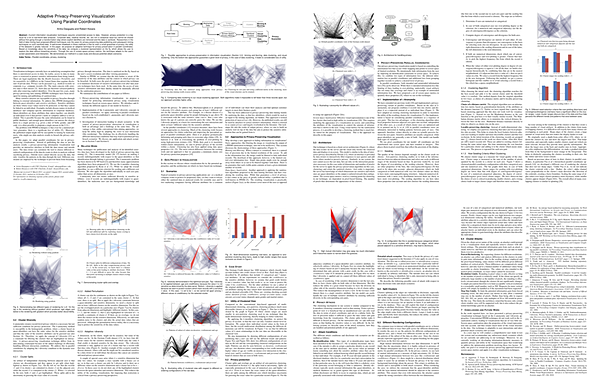Privacy-Preserving Data Visualization using Parallel Coordinates

Aritra Dasgupta, Robert Kosara, Privacy-Preserving Data Visualization using Parallel Coordinates, Visualization and Data Analysis (VDA), pp. 78680O-1–78680O-12, 2011.The proliferation of data in the past decade has created demand for innovative tools in different areas of exploratory data analysis, like data mining and information visualization. However, the problem with real-world datasets is that many of their attributes can identify individuals, or the data are proprietary and valuable. The field of data mining has developed a variety of ways for dealing with such data, and has established an entire subfield for privacy-preserving data mining. Visualization, on the other hand, has seen little, if any, work on handling sensitive data. With the growing applicability of data visualization in real-world scenarios, the handling of sensitive data has become a non-trivial issue we need to address in developing visualization tools. With this goal in mind, in this paper, we analyze the issue of privacy from a visualization perspective and propose a privacy-preserving visualization technique based on clustering in parallel coordinates. We also outline the key differences in approach from the privacy-preserving data mining field and compare the advantages and drawbacks of our approach.
@inproceedings{Dasgupta:VDA:2011,
year = 2011,
title = {Privacy-Preserving Data Visualization using Parallel Coordinates},
author = {Aritra Dasgupta and Robert Kosara},
booktitle = {Visualization and Data Analysis (VDA)},
pages = {78680O-1–78680O-12},
abstract = {The proliferation of data in the past decade has created demand for innovative tools in different areas of exploratory data analysis, like data mining and information visualization. However, the problem with real-world datasets is that many of their attributes can identify individuals, or the data are proprietary and valuable. The field of data mining has developed a variety of ways for dealing with such data, and has established an entire subfield for privacy-preserving data mining. Visualization, on the other hand, has seen little, if any, work on handling sensitive data. With the growing applicability of data visualization in real-world scenarios, the handling of sensitive data has become a non-trivial issue we need to address in developing visualization tools. With this goal in mind, in this paper, we analyze the issue of privacy from a visualization perspective and propose a privacy-preserving visualization technique based on clustering in parallel coordinates. We also outline the key differences in approach from the privacy-preserving data mining field and compare the advantages and drawbacks of our approach.},
}
